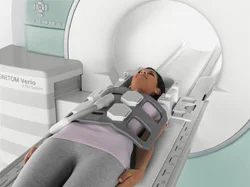Epilepsy is the third most common neurological disorder in the United States.
What is epilepsy?
Epilepsy is the third most common neurological disorder in the United States, after Alzheimer's disease and stroke. It is more common than cerebral palsy, multiple sclerosis, and Parkinson's disease combined. Epilepsy is a condition in which a patient's brain has electrical and chemical activity that leads to seizures.
What is focal epilepsy?
Focal epilepsy is the most common type of epilepsy. It happens when a person's seizures occur in one part of their brain. In a simple focal seizure, a patient does not lose consciousness, will remember what happened after the seizure has passed, and the seizure lasts for a minute or less. In a complex focal seizure, the patient may lose consciousness and will not remember what happened, and may feel sleepy or confused afterwards. There are many types of partial seizures, including "spells," seeing bright lights, mood changes, sweating, repetitive movements, tingling, body movements, and many more.
What are biomarkers?
Biomarkers are health characteristics that can be measured. Biomarkers can help doctors tell whether a person is healthy, getting better, getting sick, or responding to medication. Biomarkers could also help doctors and patients figure out the best treatments. There are many examples of biomarkers that you already know! Blood pressure, heart rate, weight, and blood sugar levels are common biomarkers that your doctor may measure for you.
Why are you studying biomarkers in HEP?
We do not yet have biomarkers for epilepsy. If we had a biomarker, we might be able to predict which treatments might help a specific patient, or when a patient’s seizures might get better or worse. HEP doctors believe that there may be such biomarkers in patients’ blood or urine.
When the HEP Biomarkers team looks at participants’ DNA, RNA, or proteins, they are looking for patterns in the molecules that are shared by people who are getting better, who have similar kinds of seizures, or who have similar responses to medication.
The goal is to one day have precision medicine for epilepsy patients—so that in the future, a patient who comes to the doctor for the first time with seizures could donate a tube of blood, the doctor would see molecules in the person’s blood, and the doctor could tell the patient about what the future of their epilepsy will be like, and which drugs and treatments will make them better faster.
What is a brain Magnetic Resonance imaging (MRI)?
A patient having an mri
Magnetic resonance imaging, an MRI, is looking with a special camera and computer at the structure in a patient’s brain. Doctors look for scars, tangles of blood vessels, and changes in the shape of the brain to help understand what might be causing a person’s seizures. Most patients with new-onset epilepsy will have a brain MRI—that is, their brain will be scanned using a camera made of a big magnet, called “Magnetic Resonance Imaging.” The MRI test doesn’t hurt, but the patient will have to lay very still, and only a doctor can decide if a patient can have an MRI.
Because the HEP team is looking at MRIs that are all taken from specially-programmed MRI scanners, the MRI Team is able to look for similarities and changes that are much smaller than some other research studies can find.
Why are we looking at MRIs in the Human Epilepsy Project?
When they look at an MRI, they look to see whether any of the patients in HEP have similarities in their brain’s tissue, or in how their brains are growing or changing over time. When the MRI Team MRI finds patterns, they look to see what other patterns the patients share—if they are getting better because of a particular medication, or if their seizures are getting better, for example. With this information, soon, patients who come to the doctor with a new diagnosis of epilepsy will be able to have a brain MRI and, because their MRI shares patterns with patients like the ones in HEP, the doctor and patient will have a better picture of how the patient’s epilepsy will go, how soon they will get better, and which medications will work best.
What is an electroencephalogram (EEG)?
An electroencephalogram (EEG)
An electroencephalogram (EEG) is made by a machine that senses your brain's electrical activity. Your brain is always making electrical activity, and seizures cause the brain to make a unique pattern (called a brainwave) on a machine called an electroencephalogram (EEG).
People with epilepsy sometimes have different brainwaves than other people, especially during a seizure, so epilepsy doctors look at EEGs to understand what kind of epilepsy and seizures a person has. Also, seizures can come from many things, so doctors look at EEGs to make sure the person has epilepsy.
Will an EEG hurt?
A child having an EEG, from kidshealth.org
EEGs are painless; it is a test in which a machine records the electrical activity in your brain through little sensors that are taped to your skin.
Why are you doing EEGs in the Human Epilepsy Project?
When the EEG Team looks at a brain EEG, the doctors are looking to see what characteristics the brainwave has. For the Human Epilepsy Project, we are looking at the patterns that will help people with epilepsy, so often the EEG Team is looking to make sure the seizures are coming from epilepsy. In this way, we make sure that every patient who has a pattern in the Human Epilepsy Project — in their EEG, their MRI, or their blood—has epilepsy (not something else), so we can make discoveries faster that will help other patients with epilepsy.
MRI Entrance
Why don't we already have precision medicine for everyone?
Doctors need more information from more patients, so that an accurate library of biomarkers can be developed. With the help of participants in the Human Epilepsy Project, who donate their DNA, proteins, and other molecules, EEG, and MRI to the study, the Human Epilepsy Project Team can develop a library that doctors will use to help future epilepsy patients. When a new patient comes in with molecules like yours, the doctors will know what treatments made you better, and will be able to offer those treatments to the new patient.
This knowledge may change the future of epilepsy care, and this is why Dr. French, Dr. Kuzniecky, and Dr. Lowenstein created the Human Epilepsy Project.
What is an Cognitive Testing?
Some of the most important things a patient’s brain does is think and remember. Doctors are always interested in whether a person’s thinking changes, especially when they have epilepsy or take medication. In HEP, doctors are studying how participants’ thinking changes by using the Cogstate Exam, which is a 10-minute online test that tries to discover whether a person’s memory and thinking is changing.
The Cogstate Exam takes about 10 minutes for a participant to complete online. Participants complete the exam 1-4 times per year.
Why are you doing Cognitive Testing in the Human Epilepsy Project?
When the Cognitive Team looks at the results of one of the HEP tests, they are looking to see whether small changes have happened in a patient’s thinking. Sometimes the changes that come from medicine and epilepsy are so small that the patient themselves might not even notice them, but if doctors were able to discover the changes sooner, the patient could have better thinking and memory.
About biomarkers in epilepsy
What are biomarkers, a more complex article by National Institutes of Health
Quest for biomarkers for epilepsy, by the Epilepsy Foundation
More information about Cognitive Testing in epilepsy.
For more information about EEG in epilepsy:
For parents: EEGs and preparing your child for an EEG
Epilepsy Action article about EEG tests
Epilepsy.com video, “EEG: Checking Brain Waves”
Epilepsy.com article, “How to read an EEG”
Medscape Article, the Role of EEG in Epilepsy Syndromes





